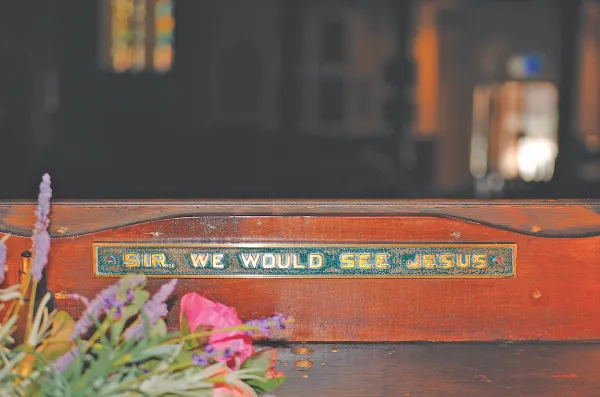Cows, Christ and the Church

Preaching the Gospel and Pursuing Unity at the County Fair
A Holy Honor
This past weekend, I had the unexpected honor of preaching the gospel at the Grays Harbor County Fair, during a joint worship gathering organized by several local churches.
I’ve preached in churches, camps, classrooms, and conferences.
But never at a county fair.
Never adjacent to a cattle auction. (Literally — I could hear them calling the auction in my left ear while I was standing there preaching the gospel!)
And never with only ten minutes to do it.
Even though I was born and raised in Grays Harbor, I can count on one hand the number of times I’ve actually been to the fairgrounds. And if I’m remembering correctly, the only time I ever went just to enjoy the fair — not to have a meeting with someone hosting a booth — was in 2001, the summer before the 9/11 attack.
I guess it just wasn’t my thing. I didn’t grow up around farming or agriculture. I didn’t know anyone in FFA, and I couldn’t tell you what 4-H actually stands for. Still can’t, if I’m honest.
But when I got the call asking if I’d come out — specifically to proclaim Christ — what else was I going to say but yes?
The Challenge of Brevity
It turns out, preaching for ten minutes is harder than preaching for forty.
With a normal sermon, I can build. I can lay groundwork, give context, follow a thread of thought, develop a theme, maybe even throw in a story or two. But with ten minutes? There’s no warm-up. No room for drift. No time to say something clever and then circle back.
Every word has to count.
Preparing this message was like trying to distill an entire Thanksgiving meal into a protein bar — not because the gospel is small, but because it’s rich. And compressing something so weighty into so little time made me ask a difficult question: What do I actually want someone to walk away with?
It was good for me. Challenging. Stretching. Clarifying.
Because when you’re forced to trim away everything non-essential, what’s left is the heart of it all:
Jesus Christ, crucified and risen.
Sin, grace, faith, and new life.
The good news — not in essay form, but in seed form.
Unity and the Things That Matter
Stripping away the non-essentials — that’s what I had to do in preparing the message. There wasn’t time to get clever, chase rabbits, or represent my denominational distinctives. I was there to proclaim Christ. That was the assignment. And in that sense, the gathering was beautiful. The gospel was preached. Jesus was lifted up.
Another local pastor gave a short devotional as the service began. He spoke about unity in the body of Christ — how we’re one family, one Church, under one Lord. And I agreed with every word. A hearty amen!
But I’d be lying if I said I didn’t still feel a tension.
The event was interdenominational — a few prayers, a devotional, a lot of music, and then me, standing up to speak for ten minutes in a field with bales of hay and bleachers for seats. It was a powerful moment. But it also raised questions I’ve wrestled with for years.
On paper, of course I believe in unity. I can — and will — make the biblical case all day long. One Lord, one faith, one baptism. There’s no time for “I follow Apollos, I follow Peter, I follow Paul” nonsense. We’re the body of Christ. We belong to one another. I believe that.
But in practice — when we sit down and actually try to do ministry together — things get complicated.
And I don’t mean petty turf wars. I’m not talking about ministerial jealousy.
I’m talking about real, meaningful differences. Baptism isn’t a salvation issue, but it is a church issue. None of us would say Communion initiates our union with Christ, but how we practice it reflects what we believe about that union.
Leadership structure, ordination, spiritual gifts, gender roles, how we read and apply Scripture — these aren’t small things. They shape the entire rhythm of a local church’s life.
Denominations exist for a reason. Not because we love division, but because we hold deep convictions about how the gospel should be taught, embodied, and passed on. We can — and should — love each other across those lines. But it’s naive to pretend those lines don’t exist.
So here’s the tension I live with: I believe in the unity of the Church (big C), and I believe doctrine matters. I want to partner wherever I can, without pretending we all agree on everything. And I want to do that in a way that’s honest — not cynical, not shallow, not papering over the differences with vague platitudes.
Unity is worth pursuing. But unity isn’t the absence of difference.
Unity is not unanimity – It’s learning to honor Christ in the way we handle those differences.
And for me, last weekend was a small, beautiful taste of that.
A Path Forward
If there’s an ecumenical path forward — a way for churches of different stripes to work together meaningfully — I’m more convinced than ever that the uniting factor must be the raw gospel of Jesus Christ.
Not just a generic mention of Jesus. Not a tack-on.
Not just “good vibes” and shared values.
But the actual message:
Christ died for sinners. Christ rose from the grave.
Repent and believe the good news.
We tend to look for unity around programs. "Let’s team up for a county-wide VBS."
"Let’s put on a joint worship night." "Let’s partner in serving the poor." And to be clear — there may be wisdom and blessing in all of that. Those can be beautiful expressions of Christian love.
But the further we move from the simple proclamation of the gospel, the harder unity becomes. Because without the clarity of the cross, our differences start to dominate. Style, structure, sacrament, strategy — all of it becomes weightier when we lose the center.
The only center strong enough to hold is the gospel.
And that’s what gave me hope this past weekend. In the middle of a fairground, next to a cattle auction, under a mercifully large tent, I got to do the one thing that actually unites us: preach Christ.
And if we can keep doing that together — not just as individuals, but as churches — then maybe there’s a future for true gospel partnership in our community.



